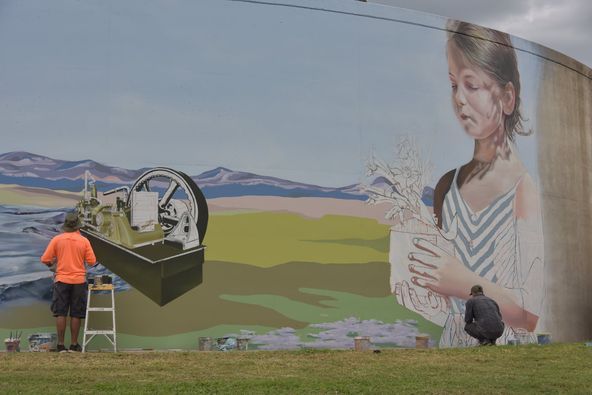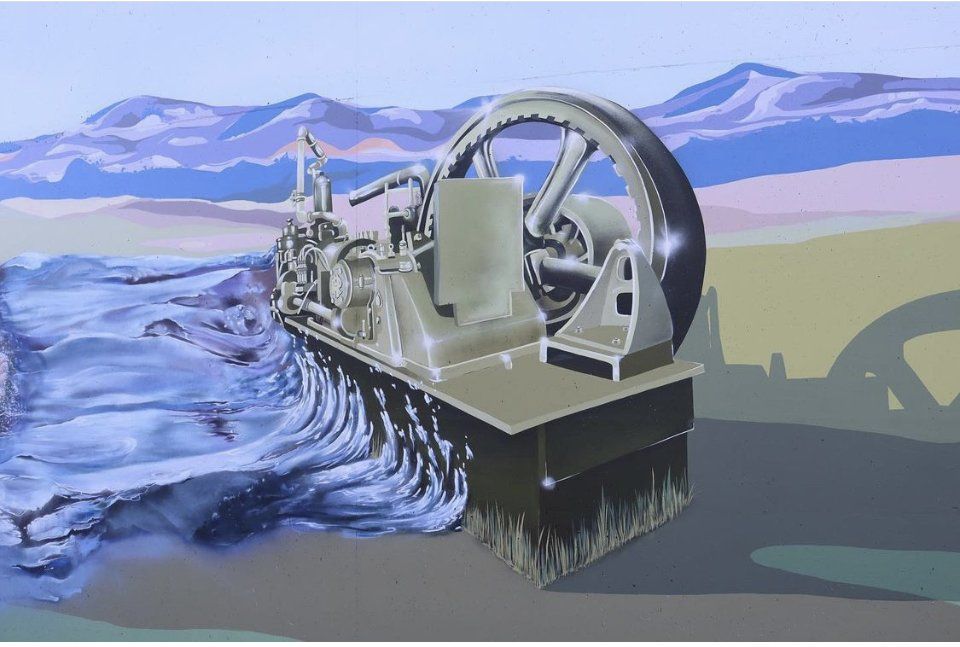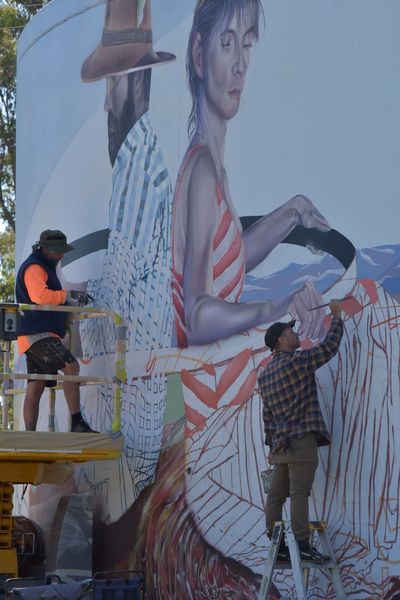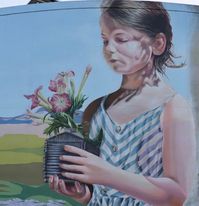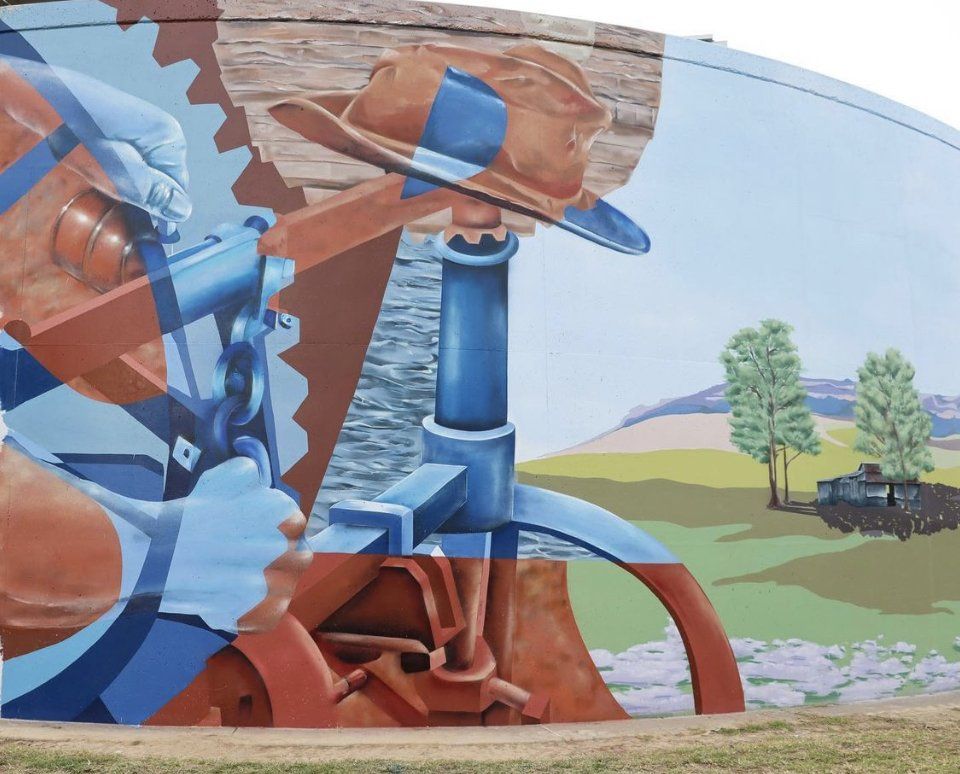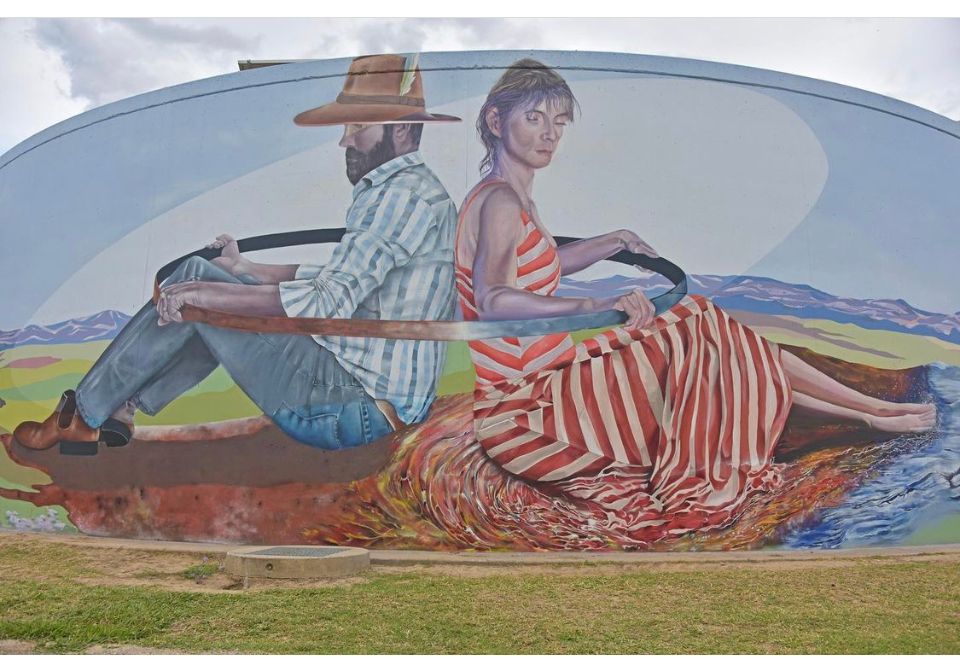
Photo by: Brightsiders
Texas Water Tank Art - Queensland
Artists: Brightsiders
Location: Stanthorpe-Texas Road, Texas, Queensland
The Texas Water Tank is located on Stanthorpe Texas Road and was painted by Brightsiders during October 2021.
The town of Texas is located on the banks above Dumaresq River with the area once devoted to growing Tobacco, raising sheep and cattle. Historically it has suffered from natural disasters including floods in 1890, 1821 and 2011 as well as a serious rabbit plague in the 1920s.
About this mural
Titled 'Turning Things Around' the artwork was commission by the Texas Arts Council to create a stunning mural that told the story of Texas and its community.
While developing the design the team at Brightsiders heard many examples of the people of Texas 'turning things around', their adaptability and their pragmatism that has served their town well.
Many of the photographs the team took in the town featured rusty old machinery, wheels and cogs from machinery of days gone by. They also heard of the significance of the Dumaresq River to the community, so based on all that was observed, the overall colour scheme of rust and water tones was used decided to be used throughout.
In one section of the mural the Dumaresq Valley creates the backdrop for a young girl who holds a miniature of a Cyprus Tobacco Barn and tobacco flower, wattle draped against her skin; a representation of the history of flora and fauna in the area.
A motor from the Texas Rabbit Works sits prominently on the ground with water spilling and lapping onto it. This pays homage to the significance of the Rabbit industry to the town as well as the importance of the river and the history of the many floods that have swept through the town.
Prominently featured on the mural are two figures sitting back to back united by the rim of a wagon wheel. This symbolism refers to the strong family and community connection that have enabled the people of Texas to turn things around. It also showcases the importance of transport in the history of the town.
Beneath the female figure, her dress of rusty tones is partly submerged and flowing into the water, representing the Dumaresq River and the many floods experienced by the town.
A motor from the Texas Rabbit Works sits prominently on the ground with water spilling all around it. This shows the history of the town and the importance of the Dumaresq River.
In the final section of the mural is a man working on an old bit of machinery. His Akubra hat perched on top of the machine, another nod to the rabbit works and the fur they once provided for the iconic hats. Stylised cogs make up the background with the texture of water and cedar wood.
The view from the silver spur mine sits behind the shacks that were once occupied by Chinese migrants in the area, acknowledging the diversity of industry and contribution of migration to the development of Texas.
Many thanks to the team at Brightsiders for the information above and the Texas Art Council for making it all possible.
FUN FACTS
The Texas Rabbit Works
The Texas Rabbit Works was built in 1928 and was the last rabbit processing works to remain in Australia. The business ceased operation in 1992 but during the period between 1930 and 1960 it was a thriving industry when rabbits were in plague proportions throughout the district. Employing 33 people and processing 6,000 rabbits a day the rabbit works was a major business in the district. Like many communities in the southern parts of Australia, the Texas community survived the great depression by trapping and selling rabbits for export to America and England.
Restoration of the building began in 2002 and in 2016; Texas Qld Inc. and the Goondiwindi Regional Council began a major refurbishment project to retain this unique piece of Australian history. The Texas Rabbit Works continues to record the history of the rabbit industry both locally and nationally.
The Town
At one point the entire town was shifted up hill in response to the ongoing flood damage that was experienced by the town.
Texas Heritage Centre and Tobacco Museum can be found at 40 Flemming Street and well worth a visit when you are in town. The Texas Heritage Centre and Tobacco Museum is located in the old Police Barracks, which was built in 1890 after the floods. It is open on Saturdays from 9.30 am - 1.30 pm and by appointment.
(Please check opening times before your arrival)
Additional Information
Geoff Appleyard writes: I have some comments for trippers going to see the Texas Water Tank from first hand experience.
Even though the tank is on the Stanthorpe - Texas road which is 95k long, it is only 3k from Texas township. Coming from Stanthorpe the last 10k into Texas the road is narrow, windy with some sharp corners & hilly as it crosses the Great Dividing range. For people towing large caravans & motorhome units drive with caution there. I'd come into Texas via Route No.2 which follows.
The easiest & best way to get to Texas is from the Cunningham Highway (Warwick to Goondiwindi). From Inglewood, the first route is only 55k of good bitumen road. The second access from Yelarbon (5k east & signposted) is also very good, bitumen & wide enough for B-doubles which we saw a few of. Travelling either of these above 2 routes lets you see Goondiwindi & Yelarbon Water tank & Silo Art as well.
Even being a Queenslander, a visit to Texas is not a common experience, & if you want to use any of the above please do, especially that the routes from the Cunningham Highway are by far the best & safest ways to see one of the latest art works.

